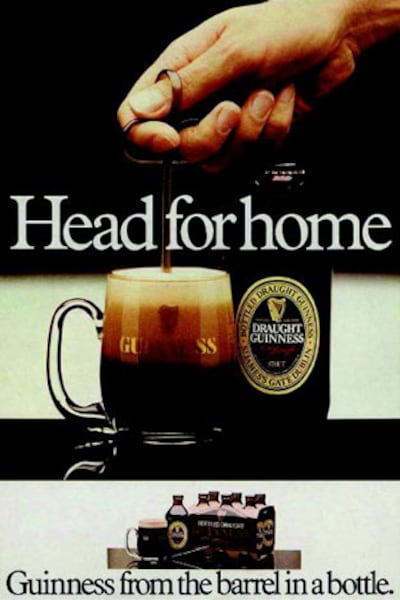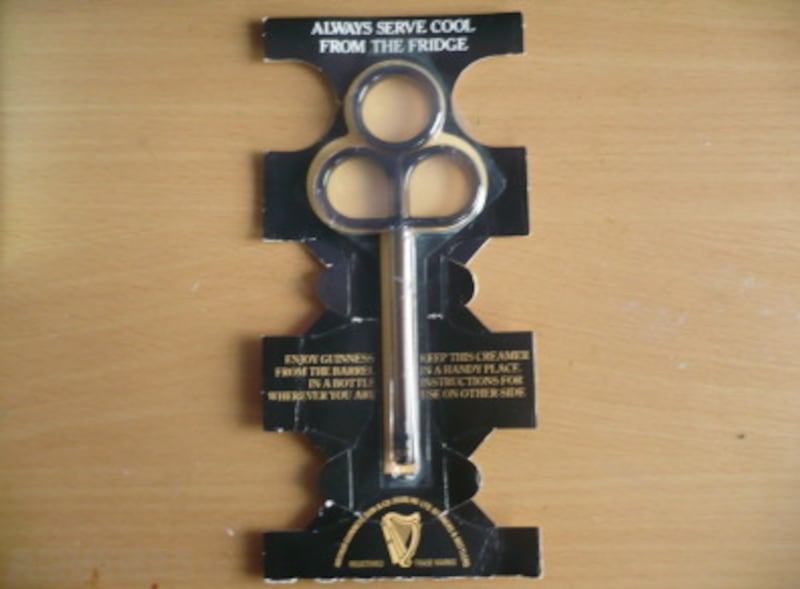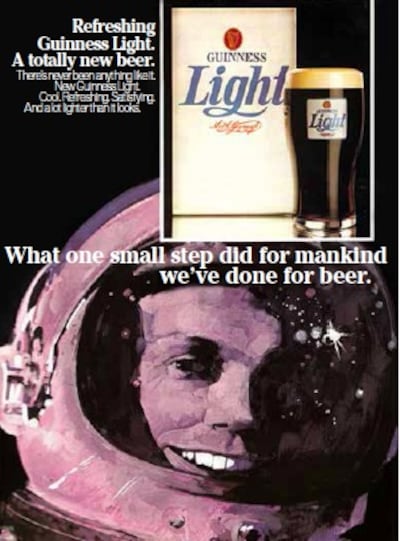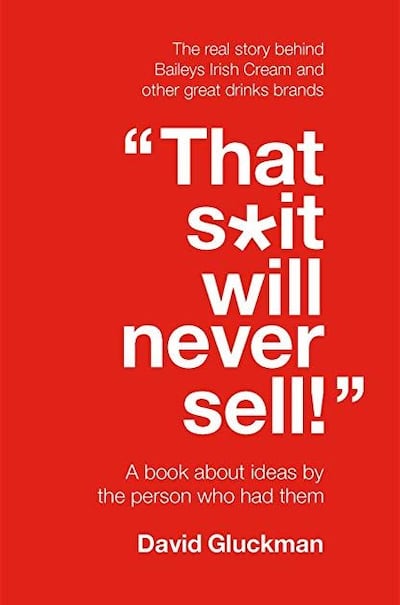The Guinness people from Dublin approached us in 1974. A man called Frank Nolan telephoned and asked if he could come to see us in Greek Street. He was grey-haired, wearing a sombre dark suit and tie and had a quiet, lugubrious manner. He could have been an undertaker.
He politely asked if we had a kitchen in the office – we did, after a fashion – and he disappeared for a minute before rejoining us. He asked us to talk about our work for a bit and then he drifted back into the kitchen.
He returned with a bottle of unidentified pitch-black liquid and a tall glass. He put the glass on the table, opened the bottle and poured out its contents. It looked still and black and utterly unappetising and he said nothing while he went through his sombre ritual.
Hugh and I looked quizzically at each other. Hugh did quizzical very well. Nolan then performed his coup de theatre by pulling from an inside pocket a smoky-grey plastic syringe that looked like a three-leaf clover. Without a word he placed the syringe into the glass of the still-black stuff, drew up some liquid and then squirted it back into the glass.
A magical transformation then occurred. The liquid became agitated and the blackness gave way to a swirling milky chocolate brown, like a Baileys whirlpool. Then it slowly separated and settled into a perfect looking glass of draught Guinness: deep, rich black-brown base with a tight-knit white creamy head. It was a sight to behold.
We were to name it "Daft Guinness" when work got under way because the notion of plunging this plastic thing into the beer seemed utterly ridiculous
I wanted to perform the ritual myself but Nolan had only brought the one bottle. He then offered us a taste and it was remarkable. It was exactly like the real draught Guinness – the kind you got in a pub in Dublin. Frank said that they called it BDG – Bottled Draught Guinness. (We were to name it “Daft Guinness” when work got under way because the notion of plunging this plastic thing into the beer seemed utterly ridiculous.) He wanted us to help them to take it to market.

He went on to explain the difference between the two Guinnesses that we knew: bottled and draught. It was all a matter of gas or bubbles. Bottled Guinness got its fizz from carbon dioxide which formed large bubbles that gave the beer a bitter “under-taste”. Exactly the same beer was used for draught Guinness, but this version was aerated with nitrogen. The nitrogen produced millions of tiny bubbles which delivered the same beer but with a much smoother creamy taste. The company had now found a way of getting dormant nitrogen into a bottle. The plastic syringe, or “creamer” as they called it, brought the Guinness to life by releasing the nitrogen. A friend said that if you were caught short without a “creamer” all you had to do was take a sip of BDG, swirl it round in your mouth and then spit it vigorously back into the glass. We tried it and it worked – but it didn’t seem like a particularly attractive selling platform.
If you were caught short without a "creamer" all you had to do was take a sip, swirl it round in your mouth and then spit it vigorously back into the glass
The work itself was really interesting and it gave me the opportunity to use my recently acquired focus group moderator skills. We did groups among regular Irish draught Guinness drinkers in Dublin. First we outlined the idea and asked them to tell us what they thought of it; next we gave them the product to “activate” using the creamer themselves, and then finally we let them taste it. And at the end of the groups, we gave each of them a six-pack plus creamer so that they could take BDG home to try out on their friends. They were invited back for follow-up groups. Not surprisingly, with all the free beer on offer, recruitment was not a problem and every single person came back for a second go.

The idea on first viewing was regarded suspiciously, especially the creamer element, which consumers renamed “the plunger”. That didn’t sit comfortably and people asked what would happen if they didn’t have one available – or if it got dirty in their pockets. The beer itself did pretty well. In fact, it did very well and there were calls for second and third glasses in each group. It was “a very respectable pint” they said but could never really match up to “the real thing”. It lacked that “extra something” that characterised the perfect pint of Guinness that you got in the best pubs.
In one of the groups I decided to take the men on and offered them a challenge. I asked the barman downstairs – we were upstairs in a pub – if he could pour a fresh pint of draught Guinness in the bar. I then poured a pint of BDG. I offered the men double their £5 attendance fee or quits if they could identify which was which. To my surprise nobody would take up my offer. Perhaps the beer wasn’t as “average” as these men had suggested.
Ladies' Guinness
After BDG, the Guinness people were satisfied with our work and we were then invited to have a look at a brand that was already on the market but not doing very well. It was called Guinness Light. The origins of the idea went back to the late 1960s and the launch in America of a beer called Miller Lite. At 4 per cent alcohol it was only marginally less alcoholic than standard US beers – but it spearheaded a new category. It was advertised on the platform of being "less filling" than other beers and one of the keys to its success was that it was endorsed in TV commercials by retired athletes, footballers and baseball stars. (I cannot see that kind of support being allowed for an alcoholic drink today.)
In the early 1970s, sales of draught Guinness were falling away among the key 18-24 age group in Ireland. Fizzy, refreshing, undemanding lagers were taking the high ground. At that stage Guinness owned almost everything in Ireland: 90 per cent of lager and bitter and about 96 per cent of stout.

Guinness Stout was central. It was the young man’s rite of passage to Irish manhood. It had to be protected. Taking a leaf out of the Miller book and riding on its success, the company decided to create Guinness Light. A lighter, less full-bodied black stout was produced which looked almost exactly like Guinness “Heavy”. It was tested exhaustively among 18-24-year-old men, their key target. The extent of the preference was extraordinary and Guinness Light looked like a sure-fire winner. We were given a truckload of research data which proved it. (As I mention elsewhere in this book, I have always been amazed at the totemic status that market research enjoys. When the “day of judgement” came for Guinness Light, the market researchers were nowhere to be found.)
It was introduced across Ireland with great brouhaha. Every pub had it and they were festooned with Guinness Light material: show-cards, drip mats, posters and special printed glasses. TV commercials featured Neil Armstrong walking on the moon with a deep-throated American voiceover proclaiming “They said it couldn’t be done” to a background of Richard Strauss’s Also Sprach Zarathustra space anthem. What the ad appeared to say was that the sheer technological genius associated with creating a watered-down Guinness was on a par with putting man on to the moon. It was puff-breasted hyperbole of the most blatant kind. And it was soon to be exposed by the hard-working Irish man-in-the-street.
Our task, should we wish to accept it, was to go and find out why Guinness Light wasn’t setting the world on fire; why its sales were falling way below expectation. What was the noise in the marketplace? We went out and carried out focus groups among young men who had seen, heard of or tried Guinness Light. We did the research in Dublin and Galway.
As I put it to my lips a hand tapped me gently on the shoulder and a man said "You're cheating. You're drinking ladies' Guinness"
Everything was perhaps best explained by a single young man we interviewed in one of our focus groups in Galway. He described his first encounter with Guinness Light: “I walked into my local bar and it was decked out with Guinness Light material. It was everywhere: posters, and beer mats. There were even special Guinness Light pint glasses. It all struck a chord. I remembered seeing a TV advert for it and I decided to order a pint. It appeared in its special glass and looked pretty tasty. But as I put it to my lips a hand tapped me gently on the shoulder and a man said “You’re cheating. You’re drinking ladies’ Guinness”.
That statement epitomised the problem. In Ireland especially, drinking is a social experience and then, more than now, pubs were broad churches, frequented by people of all ages and backgrounds. While the taste of Guinness Light may have been significantly more acceptable to young lager drinkers than regular Guinness, the idea of openly associating yourself with a weaker imitation of the real thing was an invitation to ribald comment. Guinness Light might just as well have been coloured fluorescent pink. It was not so much a case of what you liked. It was how other people regarded you.
Despite the huge research spend, the company underestimated the impact of the public house environment. They did no research among potential detractors: older draught Guinness die-hards. The name was wrong too. Guinness Light told too much of a story about the beer and the person who was drinking it. A more nondescript, less propositional name like Guinness “Special” would have represented a far more acceptable badge for the young drinker to wear. But who wanted openly to advertise that they couldn’t manage “the real thing”? Not in the 1970s and not in Ireland.
The other key mistake that Guinness made was to over-hype the new Light. One older respondent talking in a focus group piped up: “Well, they said it couldn’t be done and they were right. It couldn’t.” There was a kind of smug, self-righteous pleasure in seeing the mighty Guinness being unceremoniously brought down to earth.
There was little we could do except tell Guinness what we had heard. We did make some suggestions, but the damage had already been done. One idea we put up was they should withdraw their TV campaign and switch to radio spots – cheaper and easier to produce. They should focus on Guinness Light’s functional attribute: that it was the refreshing face of Guinness. I recalled reading that coal miners in Wales and the North-East of England drank lighter, lower-strength beers, but in huge quantities, to restore them after arduous hours underground. There was a justification for a lighter Guinness.
But it was all too little, too late. Guinness Light was a massive failure and the number of people who would have been prepared to admit that it was their idea would have rattled around on the back seat of a Reliant Robin (which is a small, three-wheeled British car).

The two Guinness projects provided a whole new slant on our development as consultants. We were inputting to other people’s ideas rather than being asked to create something new. In the case of BDG, we helped bring a pretty revolutionary idea to market. And Guinness Light was a “hindsight” job, and as everyone knows, hindsight is always 20-20.
















